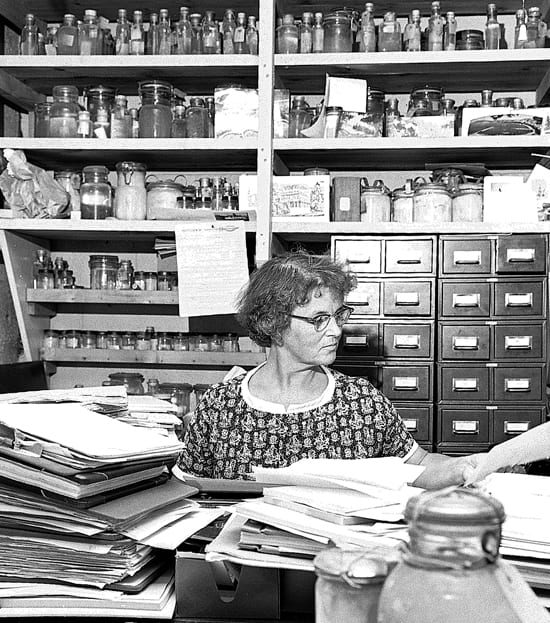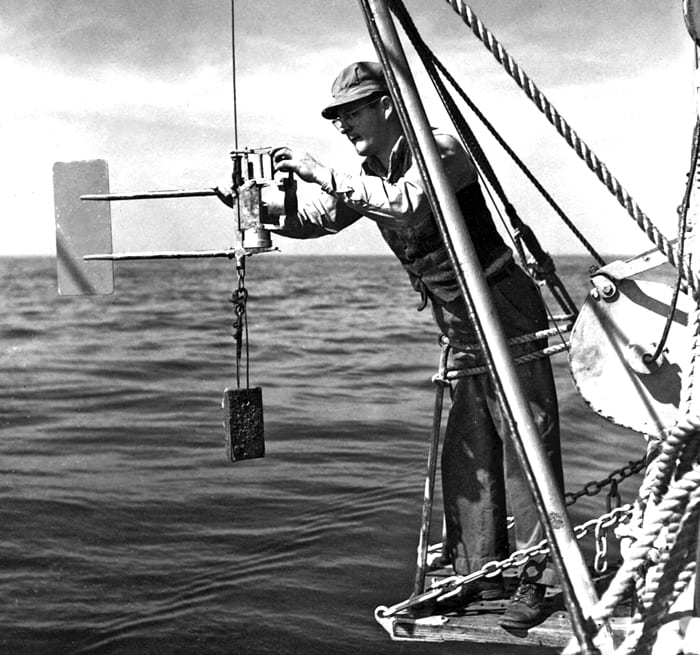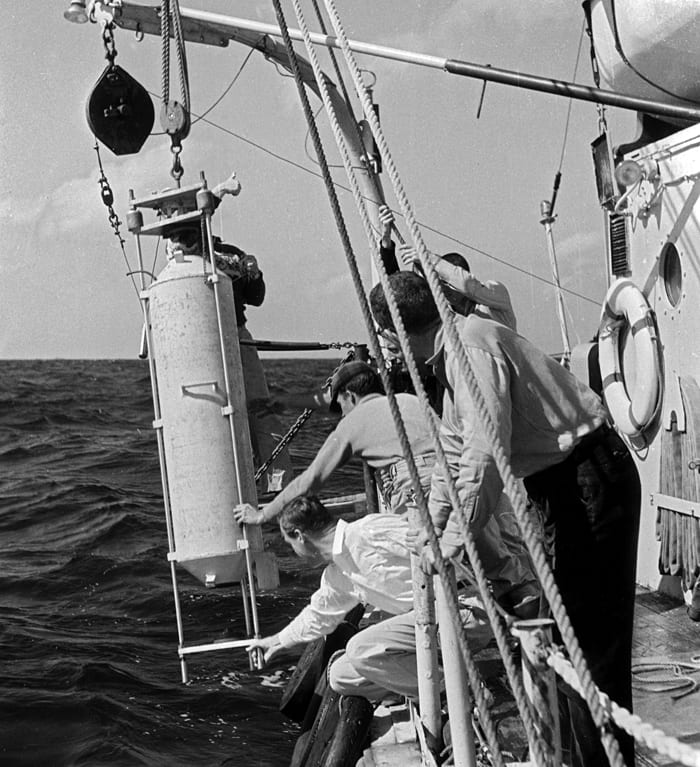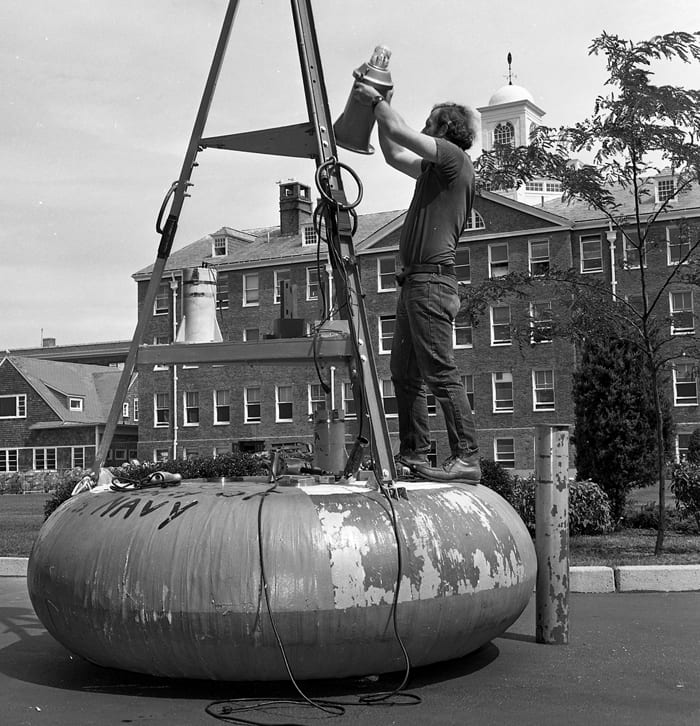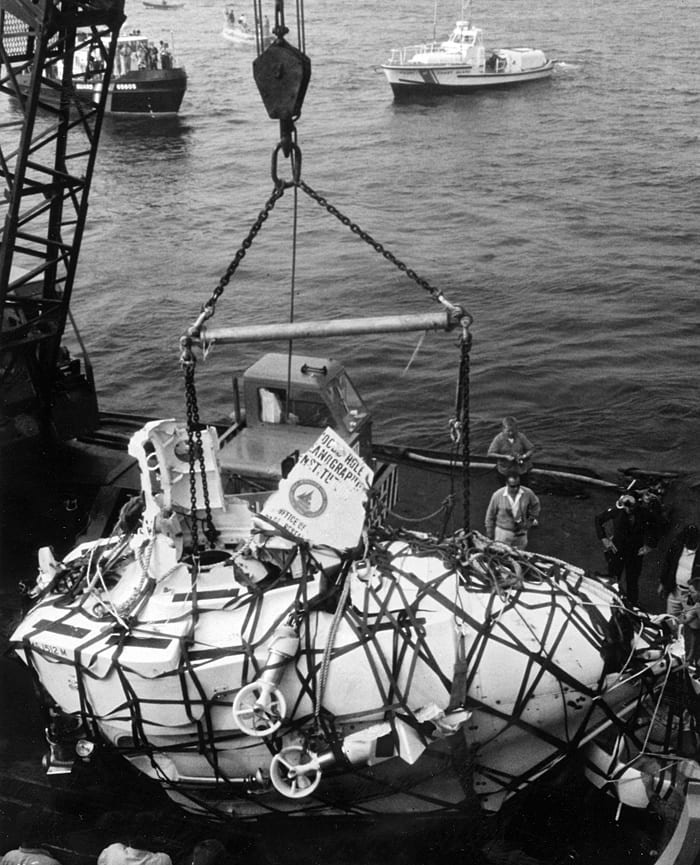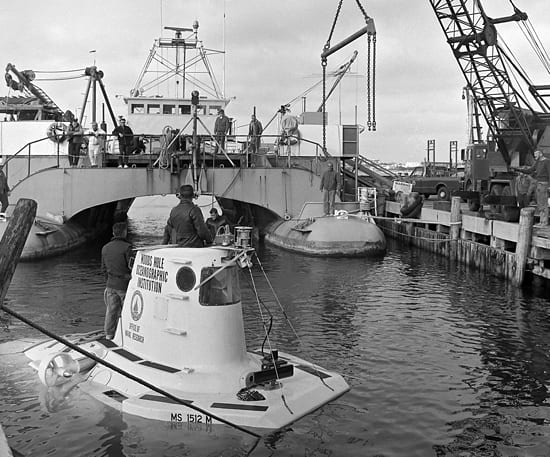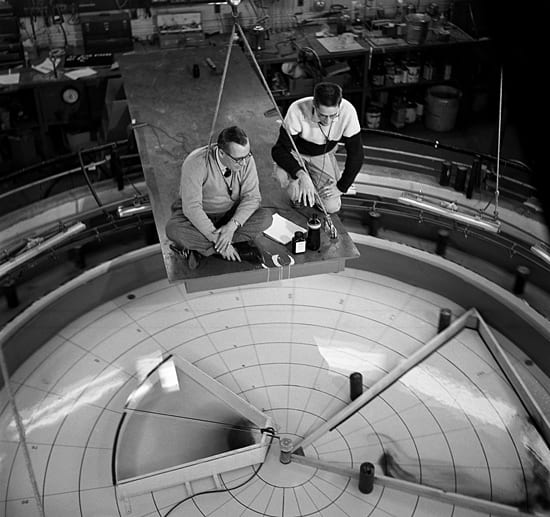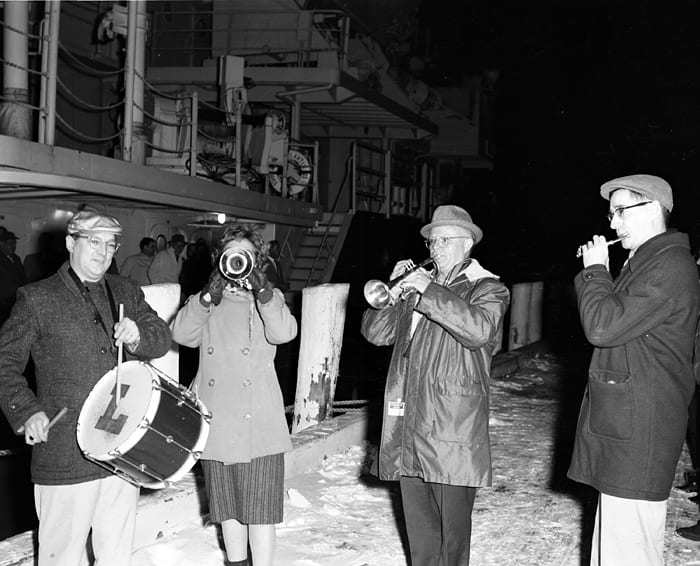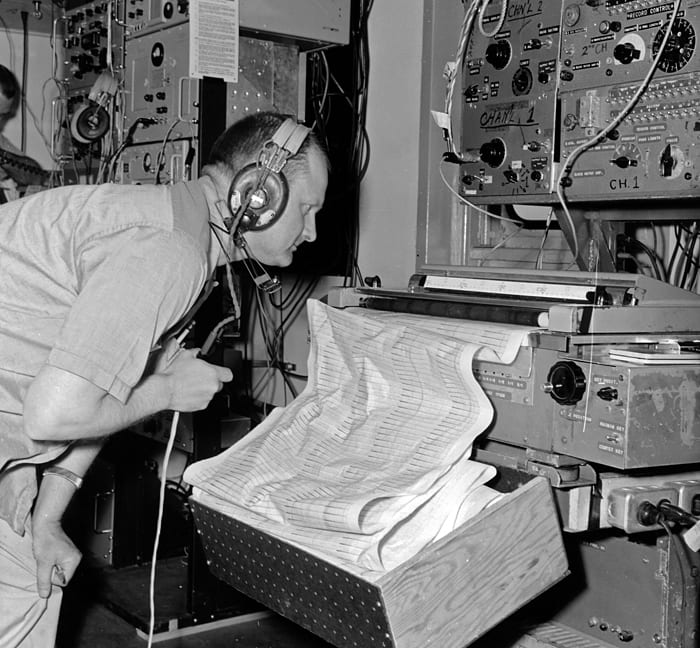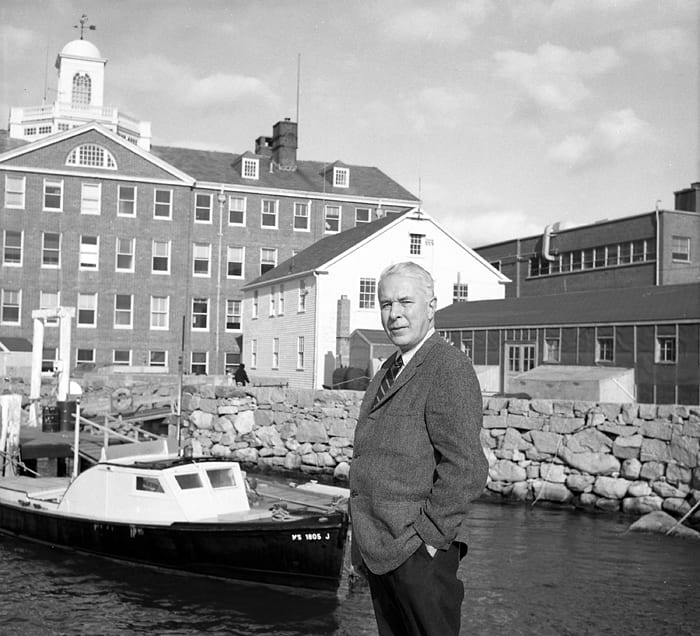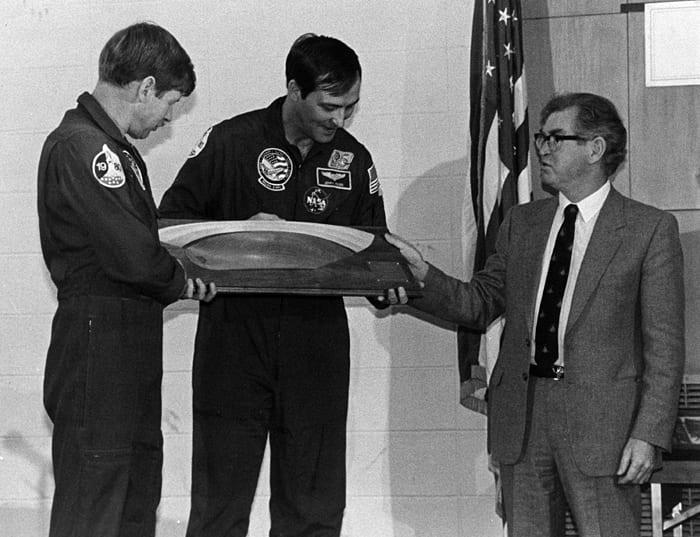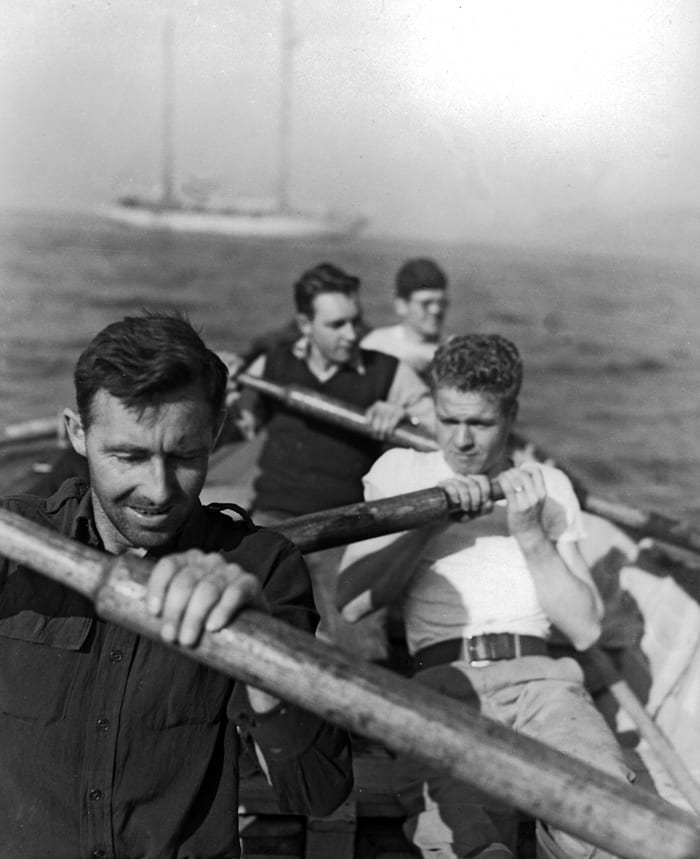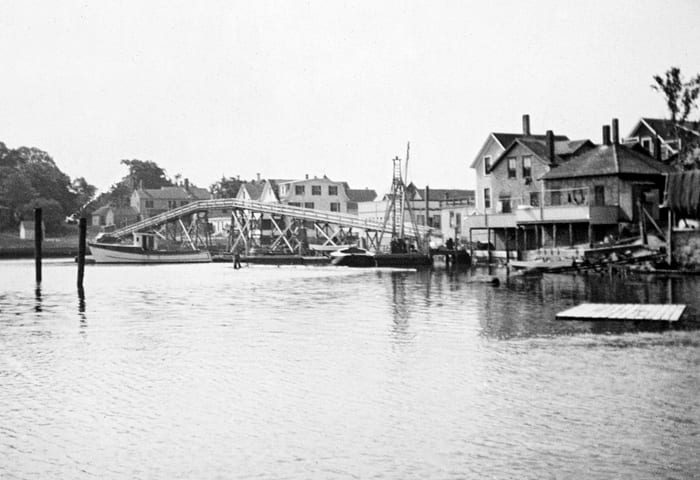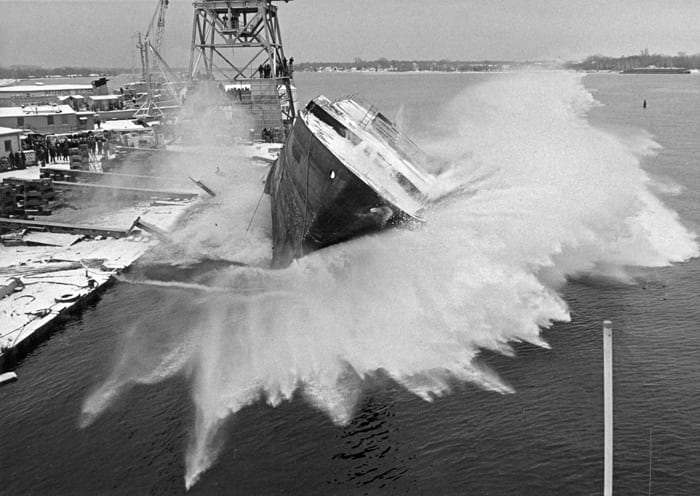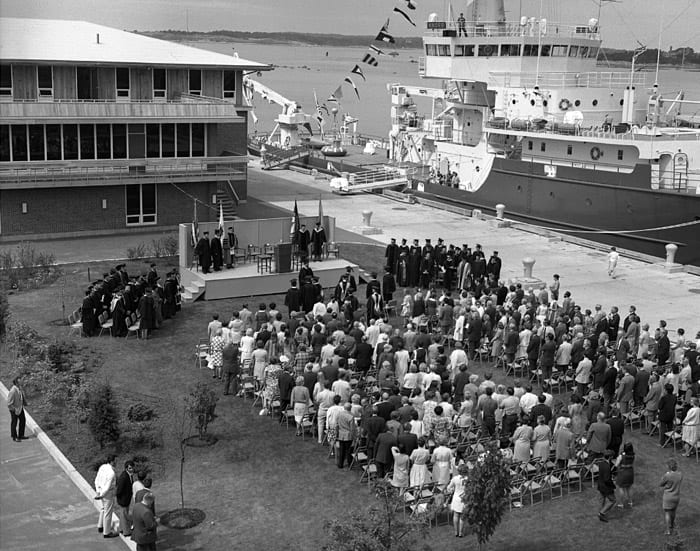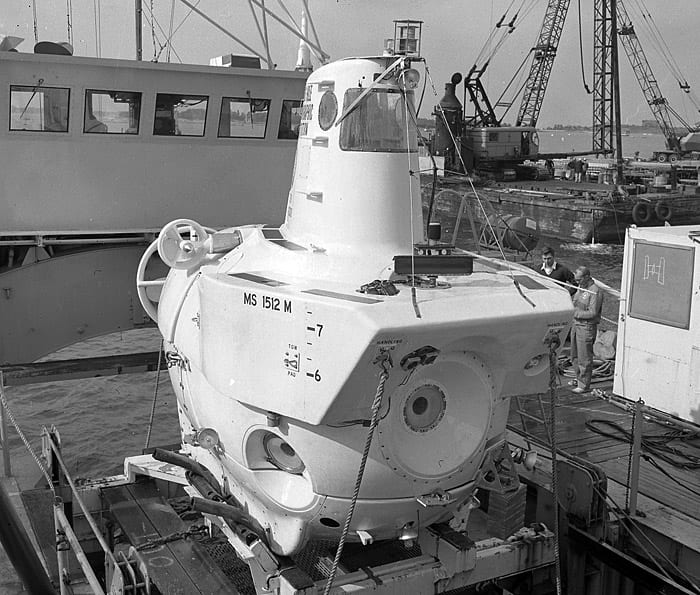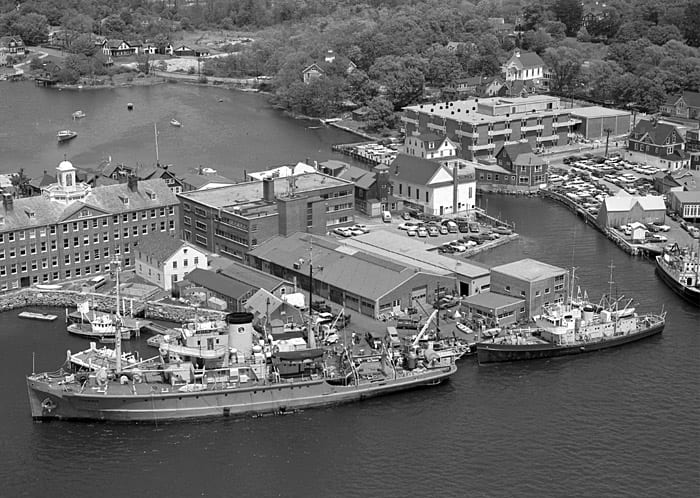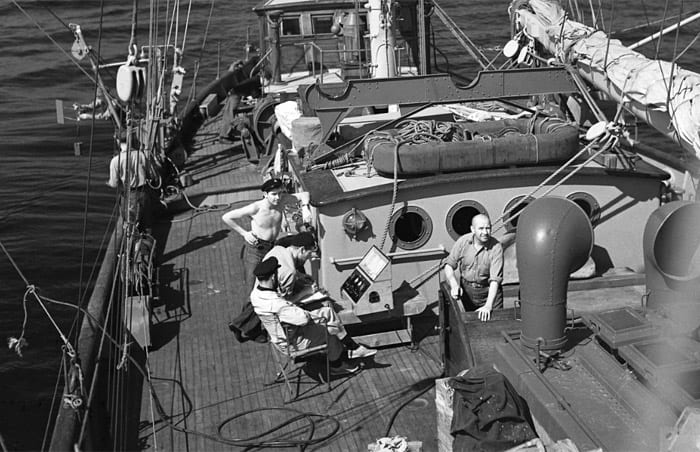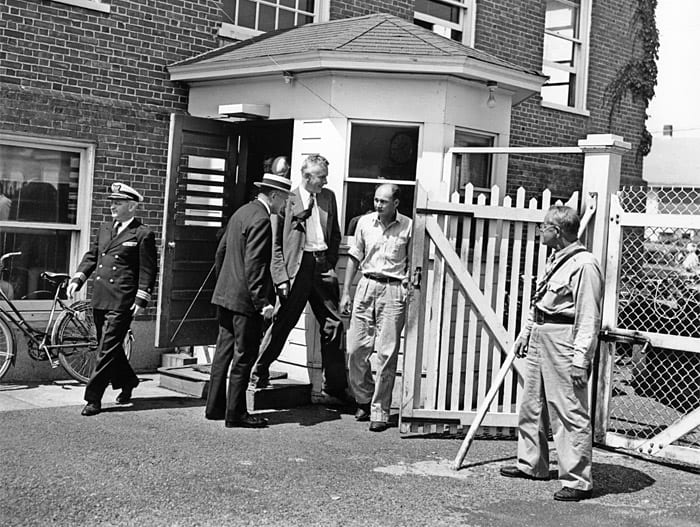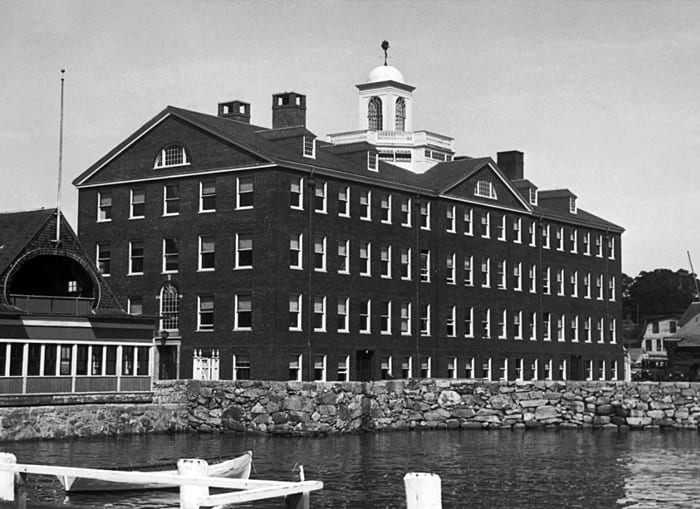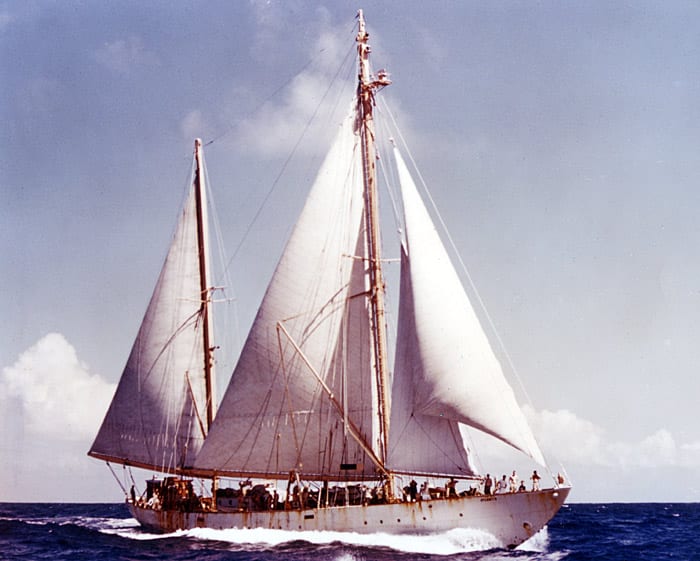- In this 1960 photo, Mary Sears is surrounded by papers and biological samples in her Bigelow Laboratory office. Sears was the first recipient of the original Woman Pioneer in Oceanography Award when it was initiated in 1994. Mary Sears passed away in September 1997 and in December 1999 the award was renamed the Mary Sears Woman Pioneer in Oceanography Award in her honor. The award recognizes long-term, life achievement and impact, with special consideration given to candidates who also have shown leadership through mentoring junior scientists, technicians, or students. (Woods Hole Oceanographic Institution)
- In 1948, Nat Corwin (above) made his first cruise on a WHOI vessel, sailing aboard the original Atlantis to the Mediterranean. He later sailed as chief scientist aboard Atlantis II when a call came to assist in the search for the sunken U.S. submarine Thresher. But Nat is best known for his many years of painstaking analysis of nutrients in seawater--at a time when there was nothing automated about collecting his data. Since retiring in 1986, Nat has volunteered in the WHOI Archives, helping document the Institution’s collection of historic photographs (Woods Hole Oceanographic Institution)
- WHOI researchers struggle to prepare a Bodman bottle for deployment during a cruise on the R/V Crawford in the late 1950s. Marine chemist Vaughan Bowen helped develop the sampling bottle, which he named for WHOI technician Ralph Bodman. Bowen studied radioactive isotopes in seawater, monitoring fallout from nuclear tests and accidents worldwide, and needed to collect large volumes of water to detect trace amounts of chemicals. He also pioneered the use of radionuclides to track the movements of trace elements through the environment, and was one of the first to focus on the transfer of materials to deep waters via the particles now known as marine snow.
(Woods Hole Oceanographic Institution) - A member of the WHOI Buoy Group mounts a flashing light on a toroid, or donut-shaped, buoy prior to its deployment in the mid-1960s. The buoy was used to suspend a mooring line that reached to the seafloor. Such moorings carried both oceanographic and meteorological instruments, with current meters mounted on the line and wind and precipitation gauges mounted on the tripod on top of the buoy. Buoy design has evolved over the years to accommodate more sophisticated instruments and longer deployments. (Woods Hole Oceanographic Institution)
- On October 16, 1968, two steel cables supporting Alvin snapped during deployment for Dive 308, 120 miles south of Cape Cod. The sub plunged about 15 feet (4.5 meters), then bobbed to the surface long enough for pilot Ed Bland, scientific observer Paul Stimson, and pilot-in-training Roger Weaver to scramble to safety. The sub then sank to the bottom where it rested in 5,000 feet (1,515 meters) of water until recovery the following year. Here the sub lifted aboard a barge after its recovery.
(Woods Hole Oceanographic Institution) - The manned submersible Alvin (foreground) undergoes testing in Great Harbor, Woods Hole, in the late 1960s. In the background is the R/V Lulu, Alvin's first tender and the namesake of the mother of Al Vine, Alvin's namesake and creator. Alvin and Lulu were oceanographic partners through the early 1980s, until the R/V Atlantis II—which could deliver Alvin to a wider swath of ocean locations—took over.
(Photo by Cliff Hinton, Woods Hole Oceanographic Institution) - WHOI physical oceanographer Alan Faller (right) and a visiting colleague conduct a circulation experiment circa 1957. Building on early studies of the Gulf Stream, Faller’s lab did illustrative experiments on a rotating turntable depicting flow patterns in bounded basins. The dark patches in the two pie-shaped basins make it easier to see the flow and circulation of water. Faller worked closely with WHOI colleague, Henry Stommel, who published the widely read book, The Gulf Stream, in 1958. (Woods Hole Oceanographic Institution)
- It's a long-standing tradition for the Woods Hole Marching and Chowder Society to welcome WHOI ships and their crews back from long voyages. Welcoming Atlantis II to Woods Hole for the first time in January 1963, are Charlie Innis, Shirley Harris, Brackett Hersey and Alan Faller.
(Woods Hole Oceanographic Institution) - Research specialist and hydro-acoustics engineer Sydney "Bud" Knott (above) is considered the father of modern echo-sounding. In the 1950s, he was the principal developer, with Warren Witzell, of the precision graphic recorder (PGR), one of the first modern echosounders. In April 1964, Knott and others at the Institution responded to a call from the U.S. Navy for help searching for the submarine Thresher, which had been lost at sea in waters near Cape Cod. As a result of his help using a PGR in the search, Knott received the U.S. Navy's Meritorious Public Service Citation, one of the highest honors the Navy grants a civilian. (Woods Hole Oceanographic Institution )
- Columbus O'Donnell Iselin, on the WHOI dock in about 1964, with WHOI's original building, the cupola-topped Bigelow Lab, in the background. Iselin served as WHOI's second director, from 1940 to 1950, following the Institution's founding director Henry Bigelow. Bigelow's student at Harvard, Iselin came to WHOI to captain WHOI's first research ship Atlantis and was chief scientist collecting physical oceanography data on trans-Atlantic cruises. Iselin was awarded the prestigious Henry Bryant Bigelow Medal in Oceanography in 1966. (Woods Hole Oceanographic Institution)
- In 1986 when the shuttle orbiter Atlantis flew its second mission, WHOI Director John H. Steele was among those invited to witness the nighttime launch, because the shuttle was named in honor of WHOI's first research vessel R/V Atlantis. After the flight, astronauts Woody Spring (left) and Jerry Ross (center) visited WHOI, and Steele presented them with a half-hull model of R/V Atlantis for NASA display. (Woods Hole Oceanographic Institution)
- Members of a 1947-48 cruise row back R/V Atlantis to the (visible in the background). The primary purpose of the six-month "Med Cruise" was to prepare bathymetric charts of the Agean seafloor in the event of a Soviet naval threat coming from the Black Sea. At the time, making such maps was done using the relatively new single-beam echo-sounders that measured the distance to a single point beneath an instrument trailed over the side of the ship. Today, the same work is carried out much more efficiently and with much more accuracy using modern multi-beam sonar systems mounted on the bottom of a ship's hull. (Woods Hole Oceanographic Institution)
- The Water Street drawbridge was carried away by a high tide during the hurricane of 1938. It was more than a year before cars could use the street again, but a temporary arched bridge accommodated foot traffic. The original Atlantis arrived home just before the storm, making an estimated 15 knots under sail along the way--it rode out the storm safely tied to a pair of moorings off the pier. Pop Schroeder's vigorous caulking kept the laboratory in the basement of Bigelow largely dry so that damage at WHOI was minor. Even Dean Bumpus's wallet, which washed out of his pocket while he was seated on a bar stool at Cap'n Kidd on Water Street during the storm surge, was found in a nearby rosebush the next spring. (Photo courtesy of Woods Hole Historical Collection)
- In 1975, the newly constructed hull of R/V Oceanus first entered the water at Peterson Builders shipyard in Sturgeon Bay, Wisconsin. During its 36-year career, Oceanus criss-crossed the Atlantic helping scientists better understand the processes that shape all of Earth's oceans and enabling engineers to design better, more capable instruments that peer deep beneath the surface. (Woods Hole Oceanographic Institution)
- The first graduation ceremony for the MIT/WHOI joint graduate program was held in 1970 on the recently completed pier with the newly delivered R/V Knorr as backdrop. (Woods Hole Oceanographic Institution)
- The submersible Alvin, delivered in 1964, is shown here in 1967 framed by its first lift system aboard tender Lulu. (Woods Hole Oceanographic Institution)
- In this 1965 aerial view of Woods Hole, WHOI's three large laboratories, left to right, are visible: the Bigelow, Smith, and Redfield buildings. The research vessels Chain, Bear and Asterias are tied to the WHOI pier, and Crawford is at the Dyer's ramp. (Woods Hole Oceanographic Institution)
- Researchers launch one current meter at upper left and monitor the readout from another at center deck during the 1947 “Med cruise,” whose major objective was making maps of the Aegean Sea floor for use by U.S. submariners in the event of a Soviet threat from the Black Sea. (Woods Hole Oceanographic Institution)
- Activity at the security gate installed during World War II gave a sense of the urgency felt by those engaged in dozens of war-related WHOI research projects, which ranged from marine fouling of ships to wake detection and underwater explosives. Photo was taken in 1946 with Columbus Iselin is at center, security guard Harry Handy is at right and Kenneth McCasland is between them. Two men on left are unidentified. (Woods Hole Oceanographic Institution)
- The Institution’s first laboratory, later named for first director Henry Bigelow, opened for science in summer of 1931 and was designed by Boston architects Coolidge, Shepley, Bullfinch, & Abbott. (Woods Hole Oceanographic Institution)
- The research vessel Atlantis, shown here in 1955 near the Virgin Islands, arrived in Woods Hole in 1931 to serve WHOI scientists until 1966, when it was transferred to the Argentine government. (Woods Hole Oceanographic Institution)
Image and Visual Licensing
WHOI copyright digital assets (stills and video) contained on this website can be licensed for non-commercial use upon request and approval. Please contact WHOI Digital Assets at images@whoi.edu or (508) 289-2647.
